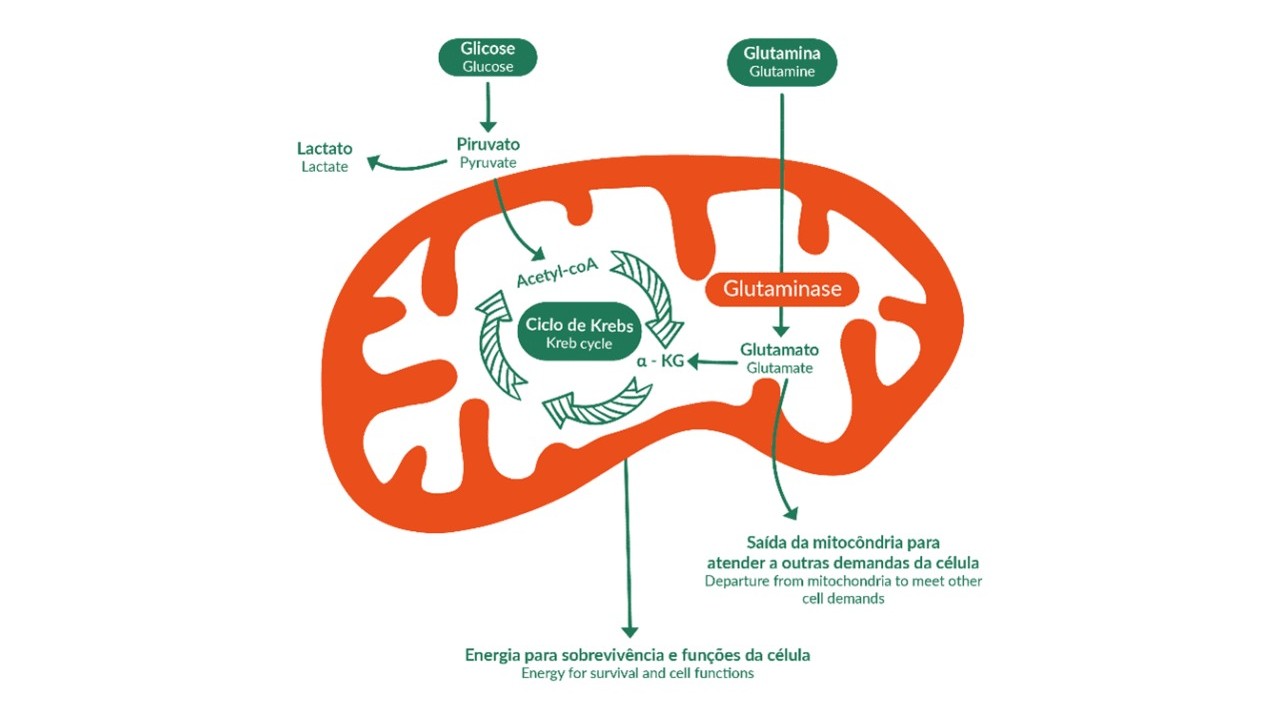

Schematic illustration showing how glutamine and glucose produce energy in mitochondria. The enzyme glutaminase is involved in both the energy cycle and the production of basic cell components (proteins, nucleic acids and lipids). In cancer cells, glucose processing is dysregulated, as is glutamine processing in many cases (illustration: CNPEM)
Promising results were obtained by a group at the Brazilian Center for Research on Energy and Materials (CNPEM), working with collaborators elsewhere. They combined inhibition of glutaminase, an enzyme that converts glutamine into nutrients for tumor cells, with inhibition of HuR, a protein that regulates the RNA of glutaminase.
Promising results were obtained by a group at the Brazilian Center for Research on Energy and Materials (CNPEM), working with collaborators elsewhere. They combined inhibition of glutaminase, an enzyme that converts glutamine into nutrients for tumor cells, with inhibition of HuR, a protein that regulates the RNA of glutaminase.

Schematic illustration showing how glutamine and glucose produce energy in mitochondria. The enzyme glutaminase is involved in both the energy cycle and the production of basic cell components (proteins, nucleic acids and lipids). In cancer cells, glucose processing is dysregulated, as is glutamine processing in many cases (illustration: CNPEM)
By Ricardo Muniz | Agência FAPESP – A study led by Brazilian researchers and reported in an article published in the journal Nature Communications proposes that simultaneously targeting the enzyme glutaminase and the protein HuR, both of which are essential to tumor progression, may be effective in treating breast cancer.
The metabolic requirements of tumor cells are associated with high levels of glutamine consumption to produce energy. The first step is conversion of glutamine to glutamate catalyzed by glutaminase, which has three isoforms (GAC, KGA and LGA) with differing relationships to tumor progression, and is a good target for treatment, according to the researchers.
“Glutaminase is important because it converts glutamine into compounds that fuel the energy and cell input production cycle. This makes it essential for cancer cells, which have a very active metabolism to sustain rapid growth,” said Douglas Adamoski, first author of the article with a PhD scholarship from FAPESP at the time of the study.
Glutaminase inhibition is therefore a common target for cancer treatment, but the researchers innovated by focusing on how HuR regulates the RNA metabolism of glutaminase as a strategy to enhance its efficacy.
“Another important aspect of the study was a groundbreaking investigation of the role of HuR in the overall control of cellular metabolism. The article shows how it regulates tumor cell metabolism by affecting key metabolic genes. This includes pathways such as glycolysis, the Krebs cycle and fatty acid synthesis, for example,” said Sandra Martha Gomes Dias, a researcher affiliated with the Brazilian Center for Research on Energy and Materials (CNPEM) and supported by FAPESP in connection with several studies on the role of glutaminase in tumor activity (14/15968-3, 15/25832-4 and 21/05726-6.
High levels of HuR correlate with increased expression of genes linked to cancer cell proliferation and survival, suggesting poor patient prognosis. Regulation of this protein may therefore also be a promising therapeutic target. “Inhibitors of small HuR molecules have been identified, and novel formulations for targeted delivery to tumor cells have been developed with promising anti-cancer activity,” Dias said.
Isoforms
The findings show that HuR, which is often overexpressed in cancer patients, plays a vital role in ensuring that the right isoform of glutaminase is produced. “When levels of HuR are low, production of GAC increases to convert glutamine to glutamate more quickly,” Adamoski said.
To reduce the expression of HuR, the researchers reduced the isoform KGA and increased GAC, making the metabolism of the cancer cells even more dependent on glutamine than usual. “By reducing HuR and at the same time inhibiting glutaminase chemically, we were able to bring about a significant drop in breast cancer cell growth and invasion,” he said.
The other co-authors of the study are researchers affiliated with CNPEM and State University of Campinas (UNICAMP) in Brazil, Washington University School of Medicine and University of Texas in the U.S., and Iuliu-Hatieganu University of Medicine in Romania.
FAPESP also supported the research line via several other scholarships and grants (20/16030-0, 14/18061-9, 20/09535-8 and 16/06625-0).
The findings suggest that combining glutaminase and HuR inhibition could be an effective strategy for the treatment of breast cancer. They point to similar conclusions to those of a previous study supported by FAPESP, in which Dias and Adamoski also participated and on which an article was published in Nature Structural & Molecular Biology.
This previous study elucidated the mechanisms whereby glutaminase activity intensifies via the formation of filaments in mitochondria. The discovery is important because tumor metabolism dysregulation plays a key role in cancer and metastasis, and is associated with poor breast cancer patient prognosis.
The article “HuR controls glutaminase RNA metabolism” is at: www.nature.com/articles/s41467-024-49874-x.
Republish
The Agency FAPESP licenses news via Creative Commons (CC-BY-NC-ND) so that they can be republished free of charge and in a simple way by other digital or printed vehicles. Agência FAPESP must be credited as the source of the content being republished and the name of the reporter (if any) must be attributed. Using the HMTL button below allows compliance with these rules, detailed in Digital Republishing Policy FAPESP.





